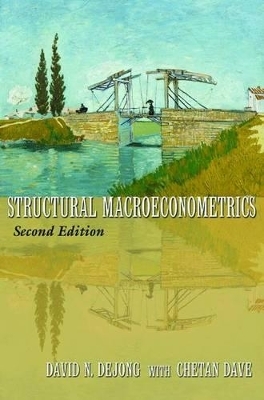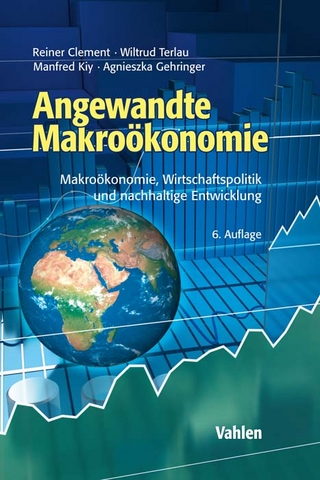
Structural Macroeconometrics
Princeton University Press (Verlag)
978-0-691-15287-5 (ISBN)
Structural Macroeconometrics provides a thorough overview and in-depth exploration of methodologies, models, and techniques used to analyze forces shaping national economies. In this thoroughly revised second edition, David DeJong and Chetan Dave emphasize time series econometrics and unite theoretical and empirical research, while taking into account important new advances in the field. The authors detail strategies for solving dynamic structural models and present the full range of methods for characterizing and evaluating empirical implications, including calibration exercises, method-of-moment procedures, and likelihood-based procedures, both classical and Bayesian. The authors look at recent strides that have been made to enhance numerical efficiency, consider the expanded applicability of dynamic factor models, and examine the use of alternative assumptions involving learning and rational inattention on the part of decision makers. The treatment of methodologies for obtaining nonlinear model representations has been expanded, and linear and nonlinear model representations are integrated throughout the text.
The book offers a rich array of implementation algorithms, sample empirical applications, and supporting computer code. Structural Macroeconometrics is the ideal textbook for graduate students seeking an introduction to macroeconomics and econometrics, and for advanced students pursuing applied research in macroeconomics. The book's historical perspective, along with its broad presentation of alternative methodologies, makes it an indispensable resource for academics and professionals.
David N. DeJong is professor of economics and Vice Provost for Academic Planning and Resources Management at the University of Pittsburgh. Chetan Dave is assistant professor of economics at New York University, Abu Dhabi.
Preface xiii Preface to the First Edition xv Part I Introduction Chapter 1: Background and Overview 3 1.1 Background 3 1.2 Overview 4 Chapter 2: Casting Models in Canonical Form 9 2.1 Notation 9 2.1.1 Log-Linear Model Representations 11 2.1.2 Nonlinear Model Representations 11 2.2 Linearization 12 2.2.1 Taylor Series Approximation 12 2.2.2 Log-Linear Approximations 14 2.2.3 Example Equations 15 Chapter 3: DSGE Models: Three Examples 18 3.1 Model I: A Real Business Cycle Model 20 3.1.1 Environment 20 3.1.2 The Nonlinear System 23 3.1.3 Log-Linearization 26 3.2 Model II: Monopolistic Competition and Monetary Policy 28 3.2.1 Environment 28 3.2.2 The Nonlinear System 33 3.2.3 Log-Linearization 34 3.3 Model III: Asset Pricing 38 3.3.1 Single-Asset Environment 38 3.3.2 Multi-Asset Environment 39 3.3.3 Alternative Preference Specifications 40 Part II Model Solution Techniques Chapter 4: Linear Solution Techniques 51 4.1 Homogeneous Systems 52 4.2 Example Models 54 4.2.1 The Optimal Consumption Model 54 4.2.2 Asset Pricing with Linear Utility 55 4.2.3 Ramsey's Optimal Growth Model 56 4.3 Blanchard and Kahn's Method 57 4.4 Sims' Method 61 4.5 Klein's Method 64 4.6 An Undetermined Coefficients Approach 66v Chpater 5: Nonlinear Solution Techniques 69 5.1 Projection Methods 71 5.1.1 Overview 71 5.1.2 Finite Element Methods 72 5.1.3 Orthogonal Polynomials 73 5.1.4 Implementation 74 5.1.5 Extension to the l-dimensional Case 78 5.1.6 Application to the Optimal Growth Model 79 5.2 Iteration Techniques: Value-Function and Policy-Function Iterations 87 5.2.1 Dynamic Programming 87 5.2.2 Value-Function Iterations 89 5.2.3 Policy-Function Iterations 94 5.3 Perturbation Techniques 95 5.3.1 Notation 95 5.3.2 Overview 97 5.3.3 Application to DSGE Models 99 5.3.4 Application to an Asset-Pricing Model 105 Part III Data Preparation and Representation Chapter 6: Removing Trends and Isolating Cycles 113 6.1 Removing Trends 115 6.2 Isolating Cycles 120 6.2.1 Mathematical Background 120 6.2.2 Cramer Representations 124 6.2.3 Spectra 125 6.2.4 Using Filters to Isolate Cycles 126 6.2.5 The Hodrick-Prescott Filter 128 6.2.6 Seasonal Adjustment 130 6.2.7 Band Pass Filters 131 6.3 Spuriousness 134 Chapter 7: Summarizing Time Series Behavior When All Variables Are Observable 138 7.1 Two Useful Reduced-Form Models 139 7.1.1 The ARMA Model 139 7.1.2 Allowing for Heteroskedastic Innovations 145 7.1.3 The VAR Model 147 7.2 Summary Statistics 149 7.2.1 Determining Lag Lengths 157 7.2.2 Characterizing the Precision of Measurements 159 7.3 Obtaining Theoretical Predictions of Summary Statistics 162 Chapter 8: State-Space Representations 166 8.1 Introduction 166 8.1.1 ARMA Models 167 8.2 DSGE Models as State-Space Representations 169 8.3 Overview of Likelihood Evaluation and Filtering 171 8.4 The Kalman Filter 173 8.4.1 Background 173 8.4.2 The Sequential Algorithm 175 8.4.3 Smoothing 178 8.4.4 Serially Correlated Measurement Errors 181 8.5 Examples of Reduced-Form State-Space Representations 182 8.5.1 Time-Varying Parameters 182 8.5.2 Stochastic Volatility 185 8.5.3 Regime Switching 186 8.5.4 Dynamic Factor Models 187 Part IV Monte Carlo Methods Chapter 9: Monte Carlo Integration: The Basics 193 9.1 Motivation and Overview 193 9.2 Direct Monte Carlo Integration 196 9.2.1 Model Simulation 198 9.2.2 Posterior Inference via Direct Monte Carlo Integration 201 9.3 Importance Sampling 202 9.3.1 Achieving Efficiency: A First Pass 206 9.4 Efficient Importance Sampling 211 9.5 Markov Chain Monte Carlo Integration 215 9.5.1 The Gibbs Sampler 216 9.5.2 Metropolis-Hastings Algorithms 218 Chapter 10: Likelihood Evaluation and Filtering in State-Space Representations Using Sequential Monte Carlo Methods 221 10.1 Background 221 10.2 Unadapted Filters 224 10.3 Conditionally Optimal Filters 228 10.4 Unconditional Optimality: The EIS Filter 233 10.4.1 Degenerate Transitions 235 10.4.2 Initializing the Importance Sampler 236 10.4.3 Example 239 10.5 Application to DSGE Models 241 10.5.1 Initializing the Importance Sampler 243 10.5.2 Initializing the Filtering Density 245 10.5.3 Application to the RBC Model 246 Part V Empirical Methods Chapter 11: Calibration 253 11.1 Historical Origins and Philosophy 253 11.2 Implementation 258 11.3 The Welfare Cost of Business Cycles 261 11.4 Productivity Shocks and Business Cycle Fluctuations 268 11.5 The Equity Premium Puzzle 273 11.6 Critiques and Extensions 276 11.6.1 Critiques 276 11.6.2 Extensions 279 Chapter 12: Matching Moments 285 12.1 Overview 285 12.2 Implementation 286 12.2.1 The Generalized Method of Moments 286 12.2.2 The Simulated Method of Moments 294 12.2.3 Indirect Inference 297 12.3 Implementation in DSGE Models 300 12.3.1 Analyzing Euler Equations 300 12.3.2 Analytical Calculations Based on Linearized Models 301 12.3.3 Simulations Involving Linearized Models 306 12.3.4 Simulations Involving Nonlinear Approximations 307 12.4 Empirical Application: Matching RBC Moments 308 Chapter 13: Maximum Likelihood 314 13.1 Overview 314 13.2 Introduction and Historical Background 316 13.3 A Primer on Optimization Algorithms 318 13.3.1 Simplex Methods 319 13.3.2 Derivative-Based Methods 328 13.4 Ill-Behaved Likelihood Surfaces: Problems and Solutions 330 13.4.1 Problems 330 13.4.2 Solutions 331 13.5 Model Diagnostics and Parameter Stability 334 13.6 Empirical Application: Identifying Sources of Business Cycle Fluctuations 337 Chapter 14: Bayesian Methods 351 14.1 Overview of Objectives 351 14.2 Preliminaries 352 14.3 Using Structural Models as Sources of Prior Information for Reduced-Form Analysis 355 14.4 Implementing Structural Models Directly 360 14.5 Model Comparison 361 14.6 Using an RBC Model as a Source of Prior Information for Forecasting 364 14.7 Estimating and Comparing Asset-Pricing Models 373 14.7.1 Estimates 380 14.7.2 Model Comparison 384 References 387 Index 401
| Erscheint lt. Verlag | 23.10.2011 |
|---|---|
| Zusatzinfo | 57 line illus. 21 tables. |
| Verlagsort | New Jersey |
| Sprache | englisch |
| Maße | 152 x 235 mm |
| Gewicht | 482 g |
| Themenwelt | Wirtschaft ► Volkswirtschaftslehre ► Makroökonomie |
| Wirtschaft ► Volkswirtschaftslehre ► Ökonometrie | |
| ISBN-10 | 0-691-15287-X / 069115287X |
| ISBN-13 | 978-0-691-15287-5 / 9780691152875 |
| Zustand | Neuware |
| Haben Sie eine Frage zum Produkt? |
aus dem Bereich


